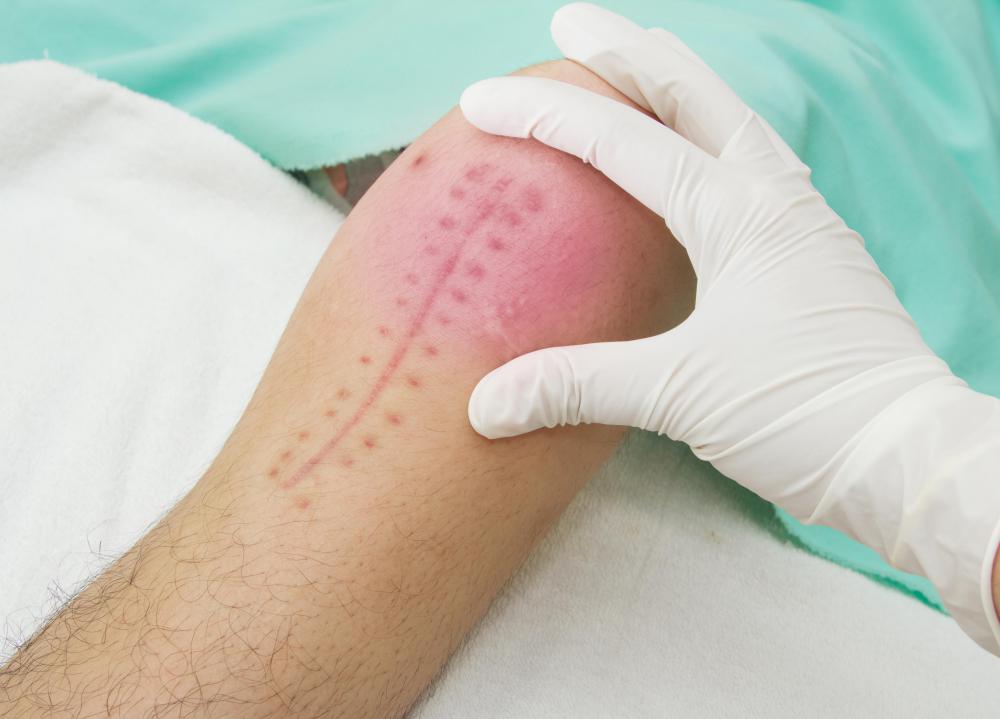At TheHealthBoard, we're committed to delivering accurate, trustworthy information. Our expert-authored content is rigorously fact-checked and sourced from credible authorities. Discover how we uphold the highest standards in providing you with reliable knowledge.
Are Stitches or Staples Better for Closing a Wound?
There are now multiple ways to attempt closing a wound. Stitches come to mind as a traditional method, but many doctors use staples, which make quicker work of wound treatment. Another way to close wounds that has been gaining in popularity is the use of adhesives, (essentially a formula similar to superglue) for superficial wound closure that leaves minimal scarring.
Considerations in effectiveness of options for closing a wound are mostly based on a few things. First, the depth of the wound may influence what choice is made. Second, how much scarring results from a wound is a factor important to patients and doctors alike. Lastly, doctors consider if any of the above methods are more likely to result in infection.

A couple of studies in the 1990s suggested that closing a wound with staples was preferable because of lower incidence of infection. One of these studies was done on fish, so it’s a little difficult to tell if higher incidence of infection could be the result of swimming around in water. Studies in the 2000s suggest that in most cases, there is little difference in infection rate between stitches and staples. Most research papers conclude that every method of closing a wound has its virtues and drawbacks.

Staples are more likely to be used quickly, and may cause less scarring since they are precise. They may be handiest in emergency rooms, where doctors must routinely perform small wound closure surgeries and are short on time. Since they may possibly be related to lower rate of wound infection, when closing a wound, they might be a best first option. Yet a wound stitched by a professional may have very minimal scarring too. On the other hand, if you have a first year resident stitching your wound, you may not like the results. Sutures techniques take practice to learn, and not every doctor is equally deft, just as not every person is good at sewing.

For small, even wounds, acrylic polymers may be a much better way to go than either staples or sutures for closing them. Much depends upon the area requiring closure, any pressure that might be exerted on that area, and the doctor’s personal preference. Since this is a matter of some debate, you might want to discuss in advance with your doctor the pros and cons of using staples, stitches or polymers.

You don’t always get a choice, especially in an emergency situation, but if you are having an elective surgery, you’ve got time in advance to discuss the benefits of each method of closing a wound with your doctor. Further, if you’re having any type of surgery that is in a visible area, discussion with your surgeon about methods is important, since you want to minimize scarring. It should be noted that any wound can cause scarring regardless of method, and any wound can become infected. It’s also true that some people have skin that scars more easily than other people do. Even the best preferred method for a wound closure may still result in more scarring than you would like if your body happens to produce more scar tissue.
AS FEATURED ON:
AS FEATURED ON:















Discussion Comments
One advantage to adhesive wound closure is that the wound is sealed off and resists microorganisms that could cause infection.
On the other hand, with stitches or staples, some part of the wound will be exposed.
In addition, adhesive closures do not need to be removed, much like stitches used in internal surgeries, which dissolve.
As a result, there may be less chance of getting an infection that could result from damaged stitches or removal of stitches or staples.
If a wound closed by an adhesive gets infected, is it more difficult for doctors to reopen and clean the wound than it would be by simply removing stitches or staples?
Post your comments